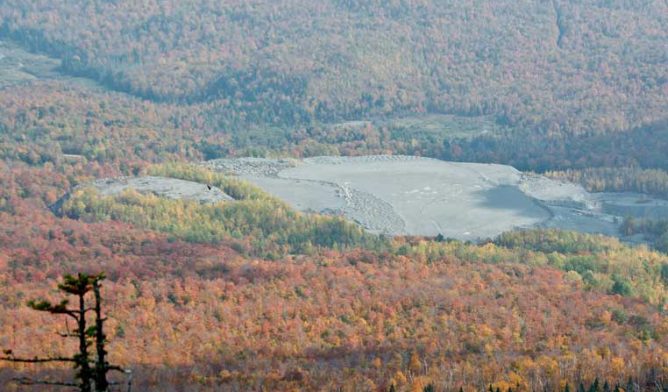Converting 30 Million Tons of Asbestos into Usable Chemicals
Asbestos Exposure & BansWritten by Matt Mauney | Edited By Walter Pacheco

New details have emerged of a plan to remove 30 million tons of asbestos waste from the inactive 1,550-acre Eden-Lowell mine in Vermont.
Solution: Move it to a proposed processing plant in Groveton, New Hampshire.
The proposal is part of long-term cleanup plan that began in 2013, when officials with the Vermont Asbestos Group reached a settlement with the U.S. Environmental Protection Agency (EPA) and Vermont state officials.
Under the agreement, Vermont Asbestos Group (VAG) will pay past and future cleanup costs and maintain the site, including protecting the public from potential environmental asbestos exposure.
The most recent chapter of the plan is to construct a processing plant in an area of a former Groveton paper mill, which city officials say has the natural gas pipeline necessary to convert millions of tons of asbestos waste into chemicals to be used in manufacturing.
It would take a $200 million investment, according to Howard Manosh, co-owner of VAG. Manosh told the Caledonian-Record that Groveton officials want the processing plant. The goal now is securing funding from an investment group.
Extensive local, state and federal permitting would also be needed to ensure safety standards are met.
“This has been five years in the making and would be another five years before it’s done,” Manosh said. “We’ve been working on it for quite a while…Hopefully, we can get something because I think it’s a good chance to remediate the waste piled up there and use it for a constructive purpose.”
Safely Moving 30 Million Tons of Asbestos
According to the 2013 negotiations, VAG has until 2023 to clean up its toxic waste site, located at Belvidere Mountain, roughly 20 miles from the border of Quebec, Canada.
Plans, while still preliminary, include extracting 75,000 cubic yards of asbestos tailings each year and transporting them to the proposed Groveton plant, where the waste will undergo an energy-intensive process to convert it into magnesium oxide, hydroxides and other chemicals.
But transporting tons of toxic asbestos waste nearly 100 miles between the Eden-Lowell mine and Groveton is easier said than done.
The proposed plans include:
- Wetting 10 to 15 percent of the tailings to prevent airborne dust during extraction
- Sealing the waste on trucks during trips
- Unloading the tailings inside a closed facility for processing
In order to remove that volume of asbestos annually, officials estimate it would take 15 to 17 truckloads each day from May through November. A single shift would be eight to 10 hours, six days a week.
No trespassing signs posted on the gates surrounding the Eden-Lowell mine warn “do not create asbestos dust.”
Asbestos is extremely dangerous if disturbed. Any dust created during waste removal puts workers and nearby communities at risk for asbestos exposure. Inhaling or ingesting airborne asbestos fibers can lead to serious diseases, including mesothelioma cancer.
Before the settlement with VAG, the EPA intervened in 2007 and 2008, creating trenches, water bars, berms and culverts to prevent asbestos tailings from seeping into nearby watersheds. The federal agency stepped in again in 2013 to address a deteriorating storage building filled with asbestos ore.
Booming Business Now a Dangerous Waste Site
The asbestos mine on the Eden-Lowell town line in northern Vermont once employed 320 people. It was one of the largest global producers of chrysotile asbestos — also known as white asbestos.
Manosh and VAG purchased the mine in 1978. For more than a decade, it turned a good profit and gave a boost to the local economy.
Asbestos is a naturally occurring mineral once highly regarded for its durability and fire-resistant properties. It was found in dozens of construction materials and products, including insulation, brake pads and concrete. But once health risks became more known, the industry began to fail.
The Eden-Lowell mine closed in 1993, leaving giant piles of asbestos tailings on the side of Belvidere Mountain. Even more toxic waste was stored in on-site buildings.
Strong winds can carry the carcinogenic asbestos dust to nearby towns. Erosion is another major concern.
The 2013 settlement agreement prohibits the movement or spread of asbestos waste outside the site — an issue that must be addressed before the Groveton plant proposal moves forward.
Another unanswered question: What should be done with the mine once the tailings are removed? Manosh told Morrisville, New Hampshire-based News & Citizen the site would be a good location for a solar array, which is a combination of multiple solar panels used to generate electricity.
But that could be a decade or more away. If it gains all approvals, the Groveton plant isn’t expected to be ready until at least 2020, Manosh told the paper.
“This project is not a done deal,” Manosh said. “Groveton doesn’t have a plant yet. I still need permission to move material offsite. These things take time.”






